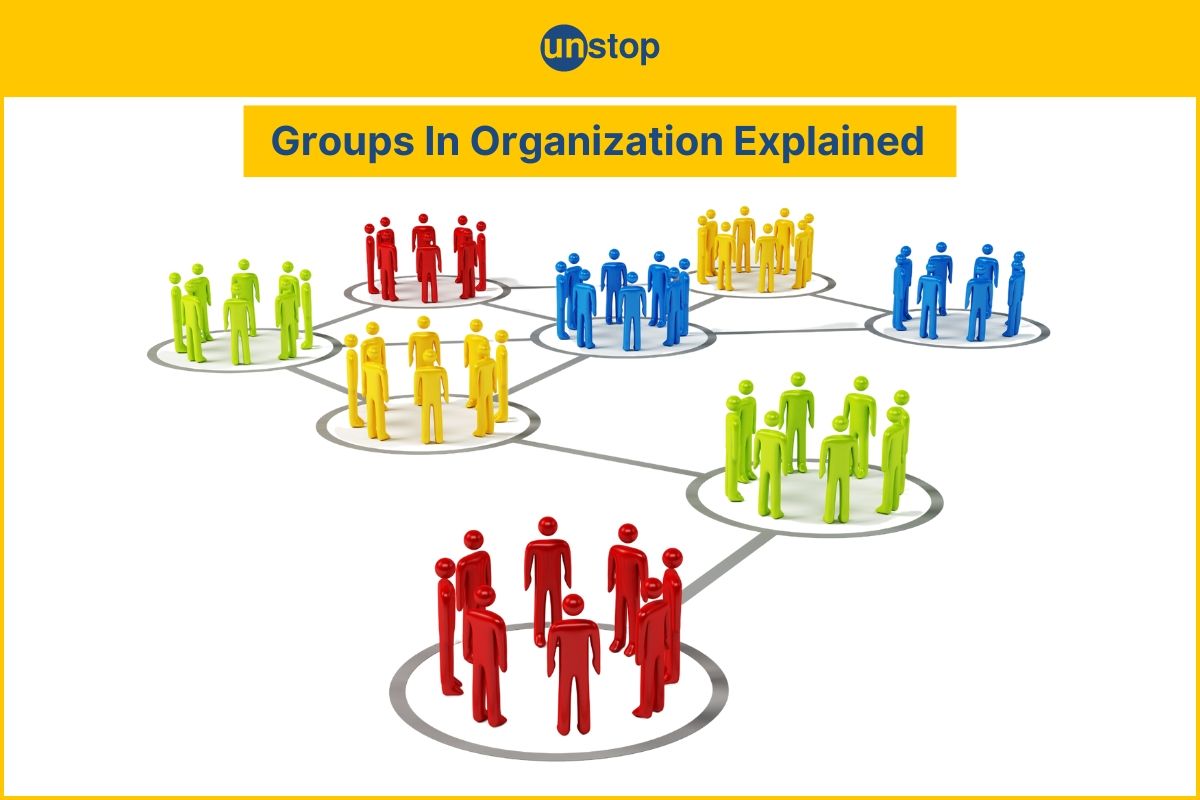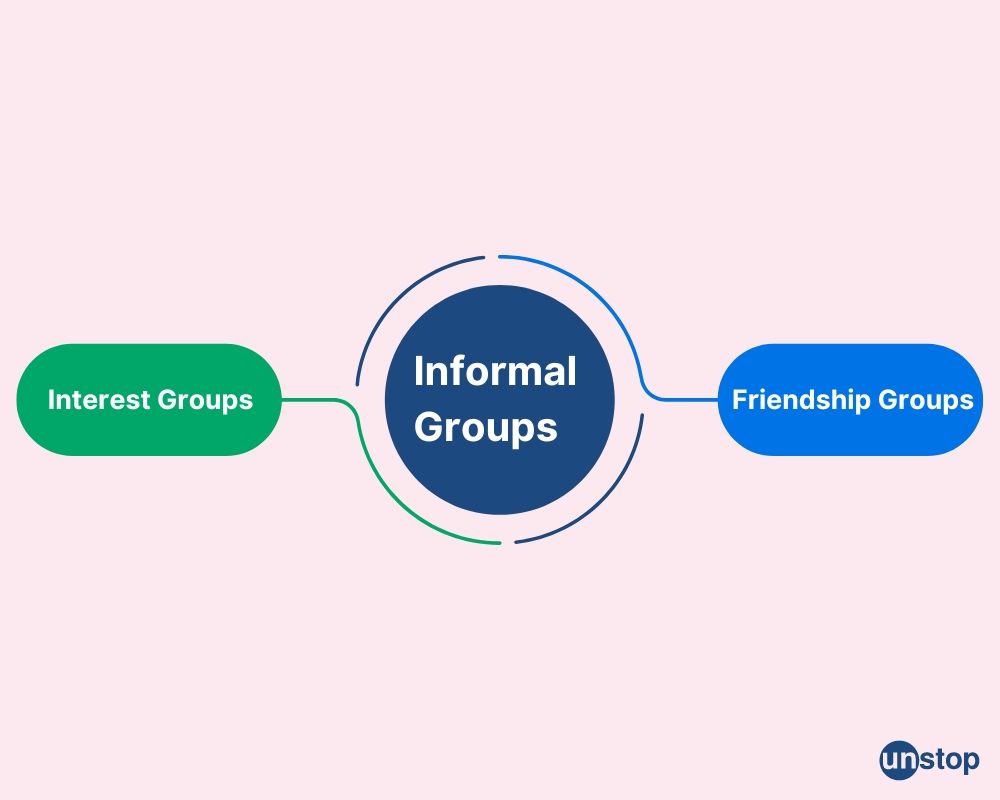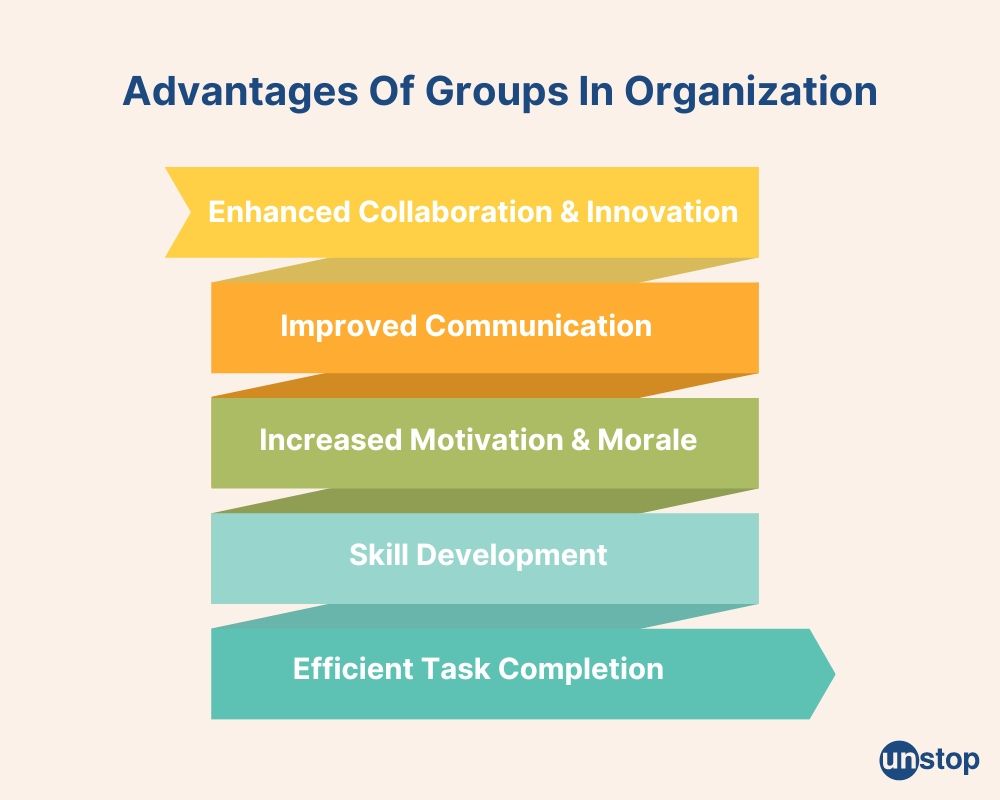- Definition Of Groups In An Organization
- Types Of Groups In Organization
- Advantages Of Groups In Organization
- Disadvantages Of Groups In Organizations
- Why People Join Groups
- Group Roles In Organizational Settings
- Task-Oriented Roles
- Relationship-Oriented Roles
- Individual Roles In Groups
- Conclusion
- Frequently Asked Questions
Groups In Organization: Definition, Types & Advantages Explained

Groups in organizations are integral to achieving collective goals and enhancing overall performance. These groups, composed of individuals working together, can be formal or informal, each serving distinct functions within the organizational framework.
The presence of groups fosters collaboration, enhances communication, and provides social support, contributing significantly to organizational effectiveness and employee satisfaction.
Definition Of Groups In An Organization
Groups in organizations are collections of individuals who interact and work together to achieve common goals. They play a critical role in the functioning of an organization, influencing productivity, morale, and overall organizational work culture.
Types Of Groups In Organization
Organizations typically feature a variety of groups, each serving distinct purposes and functions. These groups can be broadly categorized into two main types: formal groups and informal groups.
Formal Groups
Formal groups are officially recognized and established by the organization to achieve specific objectives. These groups are structured and have defined roles and responsibilities.
Within the formal group, there are specific groups assigned specific roles:

Command Groups
These are established by the organizational hierarchy and consist of a manager and the employees who report directly to them. Command groups are also known as departments or units.
Task Groups
These are created to complete a specific task or project within a defined time frame. Task groups can include members from various departments and are often temporary.
Committees
Committees are formed to address specific issues or perform certain functions, such as planning events, reviewing policies, or addressing employee concerns. They can be permanent or temporary.
Teams
Teams are groups of employees who work together on a continuous basis to achieve a common goal. Teams can be cross-functional, involving members from different departments, and are often empowered to make decisions.
Informal Groups
Informal groups emerge naturally within the organization based on personal relationships and common interests. They are not officially recognized by the organization but can significantly influence workplace dynamics.

Friendship Groups
These groups form among employees who share common interests, backgrounds, or social connections. Friendship groups often provide social support and can enhance job satisfaction.
Interest Groups
These groups are formed by employees who come together to pursue a common interest or activity, such as a sports team, book club, or hobby group.
Advantages Of Groups In Organization
Groups offer several advantages that can enhance organizational effectiveness and employee well-being.

Enhanced Collaboration & Innovation
Groups bring together diverse perspectives and skills, fostering creativity and innovation. Collaborative efforts often lead to more effective problem-solving and decision-making.
Improved Communication
Communication is made easier within groups, allowing members to share ideas and information. This helps in improving comprehension and agreement with the goals of the organization.
Increased Motivation & Morale
Being part of a group can provide employees with a sense of belonging and identity. Group support can boost motivation, job satisfaction, and morale.
Skill Development
Engaging in group activities allows members to improve their skills by interacting, giving feedback, and learning together.
Efficient Task Completion
Groups within an organization assign tasks to members according to their individual strengths, resulting in improved efficiency in completing assignments and making better use of available resources.
Disadvantages Of Groups In Organizations
While groups offer many benefits to organizations, they also come with potential disadvantages that can affect productivity, morale, and decision-making.
Groupthink
When a group values agreement too much, it can make bad decisions. People might not share different views, miss other options, and overlook risks to stay together, leading to less-than-ideal results or what is called as groupthink.
Conflict
Groups can experience interpersonal conflicts due to differences in personalities, work styles, and opinions. Unresolved conflicts can lead to tension, reduced collaboration, and a toxic work environment, negatively impacting group performance and morale.
Social Loafing
Social loafing is when people in a group exert less effort than when working alone. It happens because individuals feel less accountable and believe their efforts won't make a big difference in the group's outcome.
Decision-Making Delays
Group decision-making often takes longer than individual decision-making due to the need for discussions, debates, and consensus-building. This can delay actions and slow down processes, particularly in fast-paced environments.
Dominance
Some groups may have a small number of members who hold a lot of power and control the group's choices. This can make quieter or less confident members feel left out, resulting in a lack of different viewpoints and potentially worse decisions being made.
Diffusion Of Responsibility
In a group setting, individuals may feel less accountable for the outcome of the group's work, leading to a diffusion of responsibility. This can result in reduced individual accountability and lower motivation to contribute effectively.
Cost & Resource Intensive
Maintaining and facilitating groups can be resource-intensive, requiring time, money, and effort for coordination, communication, and conflict resolution. This can strain organizational resources, particularly if the groups are not effectively managed.
Pressure To Conform
Group members may feel pressured to conform to the group's norms and opinions, even if they disagree. This can stifle creativity and innovation, as members may hesitate to share unique ideas or challenge the status quo.
Why People Join Groups
Let us study why people resort to joining groups in an organization:
Social Needs
Individuals join groups in organizations to fulfil their social needs. Being a part of a group provides a sense of belonging and connection, meeting the innate human desire for social contact. This affiliation satisfies the need for companionship, support, and interaction within a structured setting.
Goal Achievement
Working together in a group is great for reaching goals in an organization. When people with different skills and ideas team up, they can solve problems better and make decisions faster. This teamwork often results in new and better solutions, helping both the group and the organization succeed.
Group Roles In Organizational Settings
Group roles are crucial in organizational settings as they define the responsibilities and expectations of each member. Allocating roles ensures a clear structure, enhances accountability, and maximizes group effectiveness. Efficient role distribution leads to improved communication, task allocation, and decision-making within teams.
By assigning specific roles based on individuals' strengths and expertise, organizations can streamline processes and achieve optimal outcomes. Different roles, such as leaders, coordinators, communicators, and record-keepers,s play vital roles in shaping group dynamics.
Leaders provide guidance, coordinators ensure smooth coordination, communicators facilitate information exchange, and record-keepers maintain essential documentation. When individuals understand their roles and collaborate effectively, groups can achieve cohesive teamwork, innovation, and success.
Task-Oriented Roles
In a company, task-oriented roles focus on getting jobs done well and on time. People in these roles keep things on track, summarize information, and spot any problems that might come up.
Task-oriented roles are important because they help get tasks done on time. They make sure each project runs smoothly by meeting its specific needs. These roles focus on goals, making work easier and more efficient.
Task-oriented roles are essential for the successful completion of projects within an organization. They contribute to the overall efficiency by ensuring that each task is handled appropriately. These roles help maintain a structured approach to project completion, enabling teams to meet deadlines and deliver quality results.
Relationship-Oriented Roles
Relationship-oriented roles in groups are characterized by empathy and supportiveness. Individuals in these roles prioritize building trust and fostering positive relationships within the team. These roles are crucial in fostering team cohesion by creating a supportive environment where members feel valued and understood.
By focusing on emotions and interpersonal connections, relationship-oriented roles help in strengthening bonds among team members. The emphasis on feelings and understanding in relationship-oriented roles significantly impacts group communication.
By encouraging open dialogue, active listening, and mutual respect, these roles facilitate effective communication within the group.
Individual Roles In Groups
Within group dynamics, various individual roles emerge, such as the initiator, encourager, and dominator. Each role influences how a group operates and achieves its goals. The initiator sparks ideas, the encourager boosts morale, and the dominator ensures tasks are completed efficiently.
Recognizing and leveraging individual strengths in a group setting is crucial for success. By understanding each member's unique abilities, groups can optimize collaboration and achieve superior results.
Conclusion
Understanding how groups operate within organizations is essential for promoting teamwork and reaching shared objectives. Both formal setups and informal interactions are key in shaping company culture and boosting effectiveness. Recognizing the various roles individuals fulfil in a group enables you to harness these dynamics for improved cooperation and productivity.
Whether you find yourself in a task-oriented role, a relationship builder, or an individual contributor, understanding these dynamics can lead to more effective group interactions and outcomes. Embracing the diversity of roles within a group can pave the way for innovative ideas, improved communication, and overall success.
Frequently Asked Questions
1. What are the main types of groups in organizations?
Formal and informal groups are the two main types of organizations. Formal groups have defined structures and tasks, while informal groups form based on shared interests or relationships among members.
2. Why do individuals join groups within an organization?
People join groups in organizations for various reasons, including a sense of belonging, social support, achieving common goals, enhancing their skills, networking opportunities, and gaining recognition for their contributions.
3. What are the different roles individuals play in a group setting?
Individuals play task-oriented roles focused on achieving group objectives, relationship-oriented roles to maintain harmony, and individual roles that impact group dynamics. Understanding these roles is crucial for effective teamwork.
4. How can effective group dynamics be achieved within an organization?
Effective group dynamics can be achieved by fostering open communication, encouraging collaboration and respect among members, defining clear goals and responsibilities, addressing conflicts constructively, providing feedback regularly, and celebrating achievements as a team.
5. Why is it important to understand the distinction between formal and informal groups in an organization?
Recognizing the contrast between formal and informal groups is key to understanding how relationships impact work dynamics. Leaders can use both types to boost productivity, encourage innovation, increase employee engagement, and cultivate a positive organizational culture.
Suggested reads:
- Personality In Organizational Behaviour- Types, Theories And More
- Theory Of Personality- Definition And 6 Major Theories Explained
- What Are The Barriers Of Communication | Types & Tips For Success
- Workplace Anxiety- Causes, Symptoms & Coping Strategies Explained
- Importance of Organizational Behavior: 9 Top Benefits Explained
Instinctively, I fall for nature, music, humor, reading, writing, listening, traveling, observing, learning, unlearning, friendship, exercise, etc., all these from the cradle to the grave- that's ME! It's my irrefutable belief in the uniqueness of all. I'll vehemently defend your right to be your best while I expect the same from you!
Login to continue reading
And access exclusive content, personalized recommendations, and career-boosting opportunities.
Subscribe
to our newsletter
















Comments
Add comment